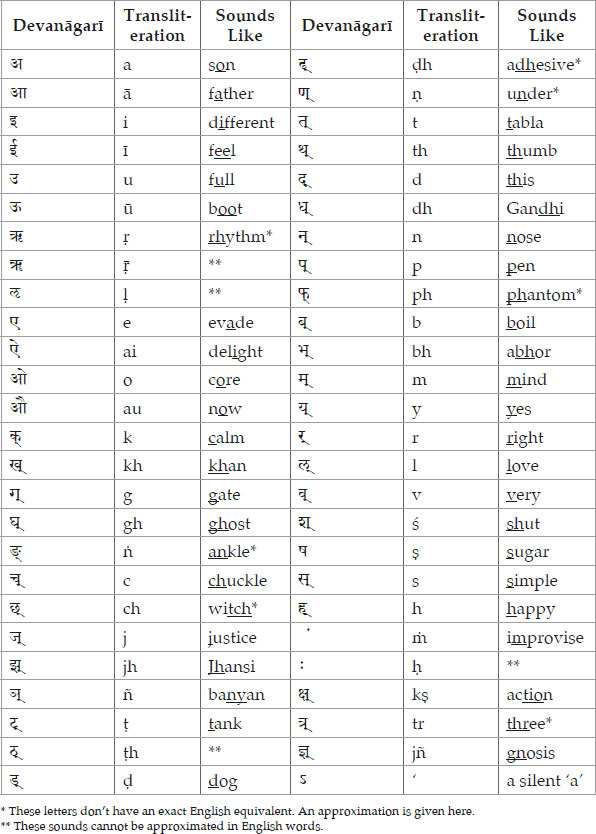Copyright Reserved Central Chinmaya Mission Trust
All rights reserved. No part (either whole or part) may be reproduced, copied, scanned, stored in a retrieval system, recorded or transmitted in any form or by any means, including but not limited to electronic and mechanical means, without the prior written permission of the publisher.
Published by:
Chinmaya Prakashan
The Publications Division of
Central Chinmaya Mission Trust
Sandeepany Sadhanalaya
Saki Vihar Road, Powai, Mumbai 400072, India
Tel.: +91-22-2803 4900
Email:
Website: www.chinmayamission.com
Distribution Centre in USA:
Chinmaya Mission West
Publications Division
560 Bridgetown Pike, Langhorne, PA 19053, USA
Tel.: 1-888-CMW-READ, (215) 396-0390 Fax: (215) 396-9710
Email:
Website: www.chinmayapublications.org
Designed by:
Chinmaya Kalpanam, Mumbai
Digitized by:
Chinmaya Digital Media, Mumbai
CONTENTS
Transliteration and Pronunciation Guide
In the book, Devangar characters are transliterated according to the scheme adopted by the International Congress of Orientalists at Athens in 1912. In it one fixed pronunciation value is given to each letter; f, q, w, x and z are not called to use. According to this scheme:
Acknowledgement
and Dedication
From the age of ten I have been practising yogsanas off and on. I enjoy doing so and have experienced its benefits. I have had occasion to go through the Patajali Yogastras which I found fascinating. Vednta, of course is the core of my life. Verses 100-124 of Aparoknubhti have always held a special attraction for me as they give a meaning according to Vednta to the Haha-yoga practices. These verses have been the basis for several of my meditation courses and camps.
An urge to write notes on them arose as I attempted to practise what I taught. In the background of solitude and sdhan the thoughts and words flowed easily. Swami Vidyrayas Aparoknubhti Dpik and Swami Akhadnanda Mahrjas commentary helped me to reflect deeper and to express my thoughts more clearly. Humble prostrations at their feet. I have enjoyed sipping these thoughts and I hope they quench your thirst too. I believe that, as Eckart Tolle puts it, I cannot tell you anything that deep within, you dont already know.
The all-pervading Lord always resides in and supports all endeavours performed with the Yaja spirit, Gt -III.15 (tasmt-sarvagata brahma nitya yaje pratihitam). Two main supports of my writing endeavours left me this time Smt. Radhika Krishnakumar, because she is very busy and Ganesh, to join the Vednta Course. I was wondering who would take up the task of editing and typing the manuscript. The Lord sent Smt. Parvathy Raman, Chennai to do the editing and Smt. Gayatri Balasubramanian of Coimbatore to do the typing. They did a commendable job. Since new editing rules were being formulated and had to be implemented as the book was getting ready, the manuscript went back and forth more than it has ever done so. Parvati-amma proved as fastidious and correct as Radhika and Gayatri-amma very accommodating and patient. Their understanding of Vednta and the yaja spirit made it an expression of joy instead of merely a job well done.
When Shri T. B. Thakur came to know of this book, he readily offered to sponsor the printing of the first edition on his own. I believe that the Lord alone accomplishes His work. May the blessings of Gurudev and the Lord be on him and his family for supporting a Chinmaya Mission publication once again.
This is a humble offering to our Param Guru, Swami Tapovan Mahrja. I share in a small way his immense love for nature, the Himalayas, the holy river Ganga and Lord iva. I also glimpse his joy in wandering, meditation and solitude. I admire his simple lifestyle, envy his dispassion (vairgya) and revere his abidance in the Truth (jna-nih). May his blessings be ever on me.
All credit for the thoughts expressed goes to the Guru Parampar. All shortcomings are due to my limitations.
Swamini Vimalananda Saraswati
Tapovan/Gt Jayanti
December, 2005.
Introduction
Life is like a huge painting, where every stroke and dot of experience contributes to the overall effect. Some experiences form the watermark or background on which others are painted. Some experiences hide others, some embellish others, some change their hues when mixed with others and some remain pure and untouched by others. Some become the central theme or purpose of life, some add beauty, some give pain, some clutter our lives and some others are of no consequence at all.
Some rare lives are masterpieces inspiring and precious, some are too abstract to be understood, some are vulgar, some good, some gaudy, some understated, some famous, some unknown, some overpriced and some a dime a dozen!
As we look on, admire, utilise, analyse or just observe the painting, we rarely think of the pure white canvas, the substratum, which made it all possible. The text Aparoknubhti draws our attention to the unique experience of this substratum of all lifes experiences.
I experience this world of things and beings in the mind, as thoughts employing the outer instruments (sense organs of perception) and inner instruments (mind-intellect). Thus all my experiences are finite by their very nature, as they are limited by the very objects I experience and the finite instruments through which I experience them. However, I, the very basis and root of all experiences, stands apart, free of all the limitations of the objects and instruments. The text Aparoknubhti makes us discover the infinite experience of Me, Myself a truly thoughtless experience!
Let us explore this unique infinite experience called aparoka-anubhti . Objects which are directly perceived pratyaka (prati [each] + aka [eye/sense organ]) are experienced through the five sense organs of perception (paca jnendriya) as sound, feel, colour and form, taste and smell (abda, spara, rpa, rasa, gandha). For example, I see the book before me with my eyes and feel the texture of the page through the skin, hear the soft rustling of its pages, and smell that strangely appealing scent that books usually have.
Objects that are far away paroka (para (others) + aka [eye/sense organ]; experienced as pratyaka perhaps by others, but not by us) are known to us either through inference based on previous knowledge or through faith in the words of others. When I see smoke over the mountain, I infer the cause, that there is a fire in the forest beyond, even if I cannot directly see the fire. When I see dark clouds, I predict that it will rain, inferring the effect from the cause. When I see a cow and a calf together, I assume that they are related as mother and child, inferring their relation from their proximity. From the above examples, we can see that both direct perception and previous knowledge are essential for inference. The science textbooks talk of neutrons, electrons and protons here my faith that prescribed educational texts are authentic, gives me knowledge. My conviction that God exists and loves all, displays faith in the words of my Guru and the scriptures.

















